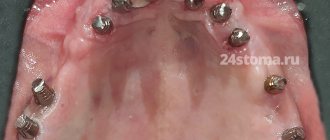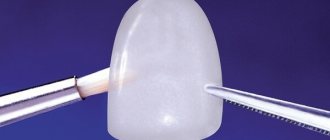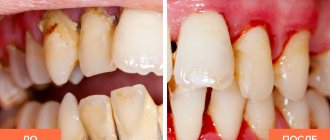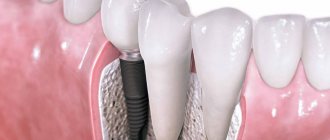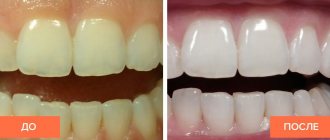A dental crown is a separate type of orthopedic structure used in dentistry to restore the shape, aesthetics and functional functions of a dental unit. Single crowns are used in the process of restoring severely damaged teeth: for example, if due to illness or injury the natural crown has been destroyed by more than fifty percent, it is more correct to restore it not with filling composites, but by installing a dental crown. Dental crowns are also actively used in prosthetics, for the restoration of missing units. Most often, a dental bridge is used for this purpose - a structure in which several dental crowns are connected. The finished prosthesis is fixed in the oral cavity on the supporting teeth, previously prepared to the thickness of the crowns. Bridges are used when there is a defect in a row with the absence of no more than two dental units in a row.
Calculate the cost of treatment by taking a short test in 20 seconds!
Do not delay your treatment, because in this matter time plays against us.
Photos of a single crown and dental bridge will help you get an idea of what the structures look like.
Before restoration with crowns, not only preliminary grinding of the supporting teeth is required: the teeth should be treated for carious damage, restored with a filling, and sometimes endodontic treatment may be required. Professional sanitation of the oral cavity is also recommended. All of the above measures allow restoration with crowns to be carried out with the highest possible quality, without the risk of complications in the future.
When is it indicated to install crowns on teeth?
The main indications for installing dental crowns are as follows:
- Severe destruction of the dental unit, in which the natural crown of the tooth has collapsed by more than fifty percent;
- In case of single defects in the dentition (when no more than two units in a row are missing in a row);
- Aesthetic restoration to achieve an attractive tooth color and shape.
Less commonly, crown prosthetics act as an alternative to orthodontic treatment in situations where it is necessary to change the position of one tooth in a row.
USEFUL TO KNOW: Teeth that are more than 50% damaged due to caries or for other reasons should be restored with a crown, not a filling. Large fillings installed quickly on pins fall out, and in addition, teeth filled under such circumstances usually come out of the bite, which can lead to its failure and disruption of the correct distribution of the chewing load.
An even worse option is that a tooth with a huge filling simply cannot withstand the pressure that occurs when chewing food and breaks, and if a pin is placed, the root of the tooth unit may also be damaged. Trauma to the tooth root suggests only one outcome - tooth extraction.
Prosthetics with crowns has not only indications for implementation, but also contraindications, which are important to exclude before starting the treatment process. Crowns are not installed:
- With mobility of the dental unit;
- Abnormally low height of the natural coronal part of the tooth, leading to the collapse of the orthopedic crown;
- When there are a significant number of teeth in rows.
It will be necessary to postpone restoration with crowns even if the diagnosis reveals an inflammatory process in the upper part of the root system of the tooth or poor-quality filling of its canals.
Under such circumstances, it will be necessary to take measures to eliminate temporary contraindications to crowns and only after that the restoration procedure itself.
When does pulp need to be removed?
Depulpation is not a mandatory procedure before prosthetics, but it cannot be avoided if there are the following indications.
- Advanced caries or caries at the very root of the tooth.
- Pulpitis or periodontitis.
- Partial exposure of nerves during grinding of enamel.
- Anatomically incorrect position of the tooth.
- Tooth injury, which may result in partial death of the nerves.
- Hypersensitivity.
- Low landing crown.
If there is a need to remove the nerve after the crown has been installed on a living tooth, then depulpation can be carried out without removing the crown. The doctor makes a hole, removes the nerve, and then fills the hole with polymer. After such a procedure, the prosthesis does not lose its performance properties.
Dental crowns: classification, overview of characteristics and prices for different types of crowns
The classification of dental crowns is carried out according to the material of production. Crowns made of metal alloys of various metals are in maximum demand: they are durable and at the same time have an affordable price for most patients. However, let us make a note - crowns made from alloys of ordinary metals - cobalt, chromium, nickel - will be inexpensive. Crowns made of precious metals are much more expensive and the price of the products will be directly related to their weight.
No less popular types of crowns are structures made of dental ceramics, which include crowns made of zirconium, porcelain, and lithium disilicate. Each type of product has its own unique performance characteristics, which will be useful to learn about in advance, if only because they will have an active influence on the price of the crown.
The cost of a crown per tooth varies from one dentist to another. At the current time, the price of a crown per tooth unit will be:
- Metal-ceramic crown - from 5 to 16 thousand rubles;
- Ceramics - from 16 to 25 thousand rubles;
- Metal crowns - about 5 thousand rubles.
USEFUL TO KNOW: Of course, the price of crowns may seem high, but it is wrong to think that it is so high only because dentists want to profit from patients. The cost of a crown depends on the cost of the material for its production and the complexity of the manufacturing technology. And the production material and technology - the strength of the crown, the timing and comfort of its operation will depend on these factors.
For example, the most inexpensive option is all-metal crowns. However, the aesthetics of such structures are extremely poor; they are practically not used for restorations in the smile area. Therefore, when choosing a crown, you should focus primarily not on the price, but on the result of the restoration you want to achieve. If aesthetics and the durability of the crown are important to you, you should choose crowns made from more expensive materials produced using computer modeling technologies. If the masticatory unit is restored with a crown, you can save money and choose a high-quality and at the same time budget option for the prosthesis.
Below we will consider in detail the features of different types of crowns and find out their approximate cost.
Installation process
The crown is installed in several stages. The number of visits to the doctor depends on the condition of the teeth and the chosen prosthetic method.
Laboratory stage
A cast of the patient's jaw is sent to the laboratory to create a plaster model of the jaw. After complete drying, the desired part is cut out. Using it, a wax prototype is made.
The model is fixed on the base and filled with a special mixture. It goes into the oven for 4-5 hours. The resulting mold is immediately filled with the alloy while it is hot. The future crown is left in this form until it hardens completely. The piece is then polished and sanded to achieve the perfect shape.
Removing the temporary structure
When the permanent crown is ready, the temporary structure is removed. It only takes a few minutes, after which prosthetics can be applied.
Installing a crown on a tooth
Before fixing the crown, a fitting is performed. If it is uncomfortable or the enamel color is not suitable, it is sent for revision. When the crown is perfect, it is secured with cement. The strength of the fixation must be checked after the material has hardened.
Monitoring the situation after installation
After fixing the crown, the doctor checks how correctly it is installed. To do this, an x-ray is taken. Only after his assessment can the patient go home. If you experience strange sensations, you should call your dentist to clarify your condition and the need for a second visit.
Our advantages
At the Beryozka clinic, the material for the crown and its type are selected individually. Each patient is given an approximate treatment estimate so that he can clearly see what he is paying for. A transparent work system, professionals, the latest equipment and materials ensure the ideal result of prosthetics at the Beryozka clinic. A polite attitude and the ability to quickly get an appointment are the key to pleasant emotions from visiting a dentist.
Metal-ceramic crowns: features, cost of prosthetics
The basis of this type of crown is a solid metal alloy frame, the average thickness of which is about 0.5 millimeters. From the outside, the metal base is covered with several layers of ceramic mass, which allows you to obtain an aesthetic appearance of the prosthesis, visually indistinguishable from natural teeth. The base can be made from both inexpensive metals and precious metals - gold and platinum.
USEFUL TO KNOW: In terms of price, a platinum crown is only slightly cheaper than a metal-free product, but at the same time its aesthetic indicators are lower, since even the precious metal will shine through the ceramics.
The advantages of metal-ceramic crowns include: reliability and durability, good aesthetics, affordable price (if we are not talking about products made of platinum or gold). The disadvantages of metal-ceramic crowns will be the following: before prosthetics, a significant amount of tissue is removed from the supporting teeth, teeth often need to be depulped first, and the gum tissue around the crown can acquire an unsightly bluish tint. This defect in metal-ceramic crowns is especially noticeable and critical when performing prosthetics in the smile area.
USEFUL TO KNOW: The defect of cyanosis of the gums occurs due to contact of the crown with soft tissues. To avoid the occurrence of such an unpleasant phenomenon, you can order in advance the production of a prosthesis with a shoulder mass, in which the lower part of the base of the product is also covered with a layer of ceramics. Prostheses with shoulder mass have a more complex production technology, and therefore their price is higher than for conventional crowns.
Having understood the features, advantages, and disadvantages of metal-ceramic crowns, we can move on to considering their cost. On average, a crown of this type, made of high-quality alloy, will cost about 8,000 rubles. If expensive ceramic materials are used for veneering the crown, allowing for high aesthetics of the product, the price of the crown will be higher and can amount to 10 thousand rubles.
The price of crowns with shoulder mass will be even higher - from fourteen thousand. Prices for metal-ceramic crowns may be lower - 5-6 thousand rubles, but usually at this price they offer products in the production of which domestically produced materials were used. Let’s be honest, the domestic product does not meet European quality standards, and therefore the finished crowns will not be distinguished by high levels of aesthetics and reliability.
Crowns with a base of gold or platinum cost about 10 thousand rubles. But the indicated amount is the cost of manufacturing the prosthesis, to which should be added the price of the precious metal per gram of weight. As a result, the price of the crown is already a different amount - from 18 thousand rubles.
It is important to note: the price of crowns does not include pre-treatment services and the cost of a temporary prosthesis.
Stages of the procedure
Based on the casts, a model of a permanent prosthesis is created in the laboratory from plaster. Since metal ceramics or zirconium dioxide are used for this, the manufacturing process can take several weeks.
Before finishing the work, the technician, together with the dentist, conducts two fittings:
- The first is to try on the crown frame.
- The second is when an almost finished prosthesis is tried on, when layers of ceramics and dyes are applied to the frame.
It is during the second fitting that the correct selection of the crown color and its shape is checked. Upon completion of the inspection, the structure is sent back to the laboratory, where the final manipulations for its creation take place - glazing and polishing.
At the next visit, the permanent crown is secured, but with temporary cement. This measure allows you to assess the level of comfort when wearing the structure, the correctness of its position in relation to neighboring units, and also eliminate the possibility of allergies.
If any problems are discovered or the patient makes complaints, urgent measures are taken to eliminate them. If no side effects are observed, the prosthesis is permanently fixed.
Ceramic (metal-free) crowns: overview of types, performance properties and prices
The main difference between such crowns and metal-ceramic analogues is that they are produced without a cast metal alloy frame and this gives two advantages at once: high aesthetics and the possibility of using crowns in patients with allergies to metals. The aesthetic and most natural appearance is ensured by the translucency of the ceramic; according to this property, the material will be almost identical to natural tooth enamel.
USEFUL TO KNOW: Opaque ceramic masses are used for veneering metal-ceramic crowns, and therefore the finished crown will look somewhat unnatural.
Ceramic crowns can be made from zirconium dioxide or E.max glass ceramics. Both crown materials have high levels of transparency and therefore products made from them will look natural and visually indistinguishable from natural teeth.
Ranking of dental crowns by nomination
| The most | |
| Aesthetic | Unaesthetic |
| Zirconium | Metal |
| Durable | Short-lived |
| Zirconium/Metal | Metal-plastic |
| Biologically compatible | Unsafe for the body |
| Zirconium/Ceramic/Metal-ceramic with gold-platinum alloy frame | Nickel-based metal-ceramic |
Zirconium crowns
An innovative CAD/CAM manufacturing technique is used to produce zirconium dioxide crowns. It allows the production of orthopedic structures with minimal human intervention. Crowns are turned using milling equipment, and their layout is made using special computer technologies.
Zirconium is a unique material; it not only has optimal biocompatibility with the human body, but also high strength, comparable to the strength of metal. The cost of zirconium crowns starts from 16 thousand rubles.
Two types of zirconium crowns can be used for restoration and prosthetics:
- Two-layer, that is, consisting of a zirconium frame, which is subsequently covered with ceramic mass. The use of this type of crown allows you to obtain the most aesthetic result of restoration, but there is also a minus - if used incorrectly, the ceramics from the frame may chip and the prosthesis will have to be restored;
- Monolithic crowns are machined from solid zirconium blocks and do not have a porcelain outer layer, but in terms of aesthetics they will be significantly inferior to the first type of product.
If prosthetics are performed in the area of the front teeth, where aesthetics are important, glass-ceramic crowns may be the best choice.
Glass-ceramic crowns E-max
Glass-ceramic crowns are an excellent option for those who want to get the most aesthetic results from prosthetics. The cost of one E-max crown is from twenty thousand rubles.
Despite all the advantages, glass-ceramic crowns have one significant disadvantage: they are applicable only in the case of single defects in the dentition. A bridge can also be made from glass-ceramics, but with no more than three crowns, and it is fixed in the area of the front teeth. These limitations are associated with the strength of glass ceramics, which will be insufficient for a massive bridge, which will also be subject to significant load (during the restoration of chewing units).
Single glass-ceramic crowns can be used for prosthetics of any teeth - front and chewing. Such crowns can be monolithic or two-layer; any type of product is produced using computer modeling technology.
Direct indications for depulpation
Dentists decide to remove a neurovascular bundle only if the patient:
- the nerve is partially exposed;
- tooth hypersensitivity;
- caries has reached the root canal;
- mechanical damage to the unit;
- anatomical pathologies (improper position of the tooth, large canal inclination).
The dentist is especially careful in choosing the method of prosthetics for the tooth that is planned to be used as a support for the structure.
Cast crowns
The main material for the production of cast crowns is an inexpensive alloy of cobalt and chromium; their surface looks perfectly smooth and even, like well-processed and polished metal. If desired, you can do a finishing gold plating. Cast crowns have good durability and wear resistance, a budget price, but extremely low aesthetics. The average cost of a cast crown is five thousand rubles.
Cast crown products are a good option for prosthetics in the area of chewing teeth; they do not require significant grinding of the teeth that support the fixation of the prosthesis. If such crowns are placed in the smile area, they can be additionally lined with special plastic overlays to achieve greater aesthetics.
Stamped crowns
In modern dentistry they are used extremely rarely, since they have few advantages, but a significant number of disadvantages. Stamped crowns are produced from a special type of blank - metal sleeves. Such a crown can be made with gold or silver plating.
As mentioned above, crowns using the stamping method were valued for their low price and the absence of the need to sharply grind the supporting teeth, but stamped crowns do not have an aesthetic appearance, quickly deform, and do not fit tightly to the neck of the tooth, which is why residues can get under the crown food, saliva and, naturally, pathogenic microflora. Caries under stamped crowns was not uncommon!
How to properly care for crowns
The method of caring for crowns is practically no different from the principles of caring for natural teeth and involves:
- performing oral hygiene twice a day (not only the teeth, but also the tongue should be brushed);
- cleaning the spaces between teeth and the space under dentures. To ensure the proper level of hygiene, it is preferable to use an irrigator: a directed jet helps to quickly and painlessly clean the space under the product;
- nutrition correction - excluding too hard foods and temperature changes from the menu;
- monitoring the condition of the gums and areas where teeth meet crowns (this is where caries most often develops);
- using mouth rinses after each meal (special formulations can be replaced with plain water).
Dentists also advise periodically massaging the gums under the structure. Soft tissues undergo increased pressure, so it is important to stimulate blood circulation in these areas. The gums should be massaged with smooth circular movements clockwise and counterclockwise.
Gold crowns
Gold crowns are not installed in every dentistry - working with precious metals requires a special license, which is quite difficult to obtain. Moreover, the cost of a finished gold crown is equal to the price of a more aesthetic ceramic crown, so it is unlikely that you will be able to save money on installing gold dentures.
The price of a gold crown will be calculated as follows: the price of the precious metal in grams is added to the cost of manufacturing the prosthesis. The total amount of precious metal that goes into the production of the crown is taken into account. How much metal is required is a difficult question to answer; it all depends on the tooth, its position in the row, and the anatomical features of the structure.
Metal-plastic crowns
Another name for this type of crowns is combined. The structural structure of the crowns is as follows: a cast metal alloy frame, which is additionally covered with a white plastic mass. The advantage of combined crowns is an affordable price, as well as acceptable aesthetics. The average cost of metal-plastic crowns starts from five thousand rubles.
However, combined crowns have a number of disadvantages that are definitely worth considering:
- The plastic finish of crowns very quickly loses its visual appeal; it may turn gray or yellow. Plastic tends to absorb moisture from the external environment and therefore the plastic layer swells and an unpleasant aroma begins to emanate from it;
- Combined crowns do not have high strength indicators; they can break due to excessive loads; most often, during the chewing process, it is the finishing plastic lining that falls off.
Plastic has fairly low biocompatibility rates, so metal-plastic crowns are not recommended for installation by people prone to allergic reactions.
Combined dental bridges with crowns made of different materials
Bridges for crowns made of metal-ceramics and crowns made of metal are made on the same base - on a frame cast from a metal alloy, and therefore crowns from different materials can be combined on a bridge of this type. For example, crowns that fall into the smile zone can be made from more aesthetic metal-ceramics, while crowns that are invisible to others can be made from metal.
The work on manufacturing a combined bridge will not be highly complex, but the overall cost of prosthetics with crowns will decrease, which is not always adequately perceived by doctors seeking to make money on their patients. If you are assured that a combined bridge with crowns cannot be made in your case, you are being deceived and it probably makes sense to go to another dentistry, where the patient’s wishes are perceived and taken into account.
At the dentist's appointment
- Try to listen carefully to the dentist about possible prosthetic options. Do not hesitate to ask questions (your understanding of the treatment process is very important).
- Make a decision on one or another prosthetic option. Ask about the timing and total cost of treatment. Ask for a detailed treatment plan indicating the full cost, payment schedules and treatment time frames.
- Check the warranty period. Read the contracts carefully. If something worries you or you have doubts, do not hesitate to take a time out.
Remember! It is better to consult several doctors before starting anything.
Avoid! Promises and bravado, if you have previously consulted with several doctors and only one promised you what others refused, then we advise you to contact those who refused.
Carefully! If the clinic lures you into paying the full amount of treatment immediately REMEMBER that you will not get it back. Try to avoid clinics with this approach to taking money despite the discounts offered.
Crowns on implants
The price of implant crowns will largely depend on the material used to make the crown and abutment. Typically the following options are selected:
- Metal-ceramic crown + titanium abutment. The price of a crown will be 15 thousand rubles per tooth;
- Zirconium crown and zirconium abutment. The price of a crown starts from 25 thousand rubles.
Of course, prices for crowns on implants are higher, but the high cost in this type of prosthetics is due to the more complex process of making crowns.
Calculate the cost of treatment by taking a short test in 20 seconds!
Do not delay your treatment, because in this matter time plays against us.
Possible complications
Depends on how the crown is placed on the tooth. If all indications and contraindications for prosthetics are observed, the correct choice of dental material, prosthetic technique, and high-quality performance of all work, complications, as a rule, do not occur or are reduced to a minimum. Sometimes the cause of complications is the individual characteristics of the patient’s body.
Pain under the crown
After treatment and prosthetics, moderate pain may persist for some time (1–5 days), decreasing in intensity. But if the tooth under the crown hurts, and the pain does not decrease, but increases, tissue swelling appears, pus is released from the gums or the temperature rises, you should immediately consult a doctor - this is a sign of an inflammatory process. The cause of inflammation may be incompletely cured caries or incompletely removed pulp from the root canals. Another reason is violations during the installation of the prosthesis, its loose fit to the remains of the natural crown and infection getting under it.
Pain under the prosthesis with irradiation into the jaw also occurs when the root canal is perforated with a pin or when a small part of the instrument used to clean the root canal is broken off. What to do: you should not try to treat a bad tooth on your own; this requires urgent help from a dentist. Usually the crown is removed, the pathological process is treated, and then the crown is reinstalled (new or old, if it is not destroyed). Sometimes pathology can be eliminated without removing the crown, simply by drilling a hole in it. The hole is then repaired using photo-curing filling materials.
If the toothache under the crown is very severe, before seeking medical help, you can take a painkiller: Paracetamol 500 mg tablet, Ketorol 10 mg or Naise 100 mg.
Unpleasant smell
Indicates the presence of an infection in the mouth. This may be a slow inflammatory process, or it may be an acute one, in which case the tooth also hurts. The cause of an unpleasant odor from a tooth under a crown can also be insufficient oral hygiene, smoking and eating a lot of sweets. What to do: consult a doctor; this symptom can only be eliminated in the dentist’s office.
Allergy
Allergic reactions are most often associated with the installation of crowns made of non-precious alloys of metal and plastic (acrylic). Redness and swelling of the gums and pain appear. The allergic process is dangerous because it can quickly spread to surrounding tissues. At the same time, the tissues of the larynx swell, breathing is impaired (Quincke's edema). What to do: contact your dentist immediately. Help consists of replacing the prosthesis that has caused an allergy to a structure made of a different material. At home, the patient can take a tablet of any antihistamine: Zodak, Claritin, Tavegil, etc.
Caries
The cause of the development of dental caries under the crown is most often incompletely cured primary caries. But sometimes, even after careful treatment, caries develops again (secondary caries). This happens especially often when the crown does not fit tightly (an infection gets under it), poor oral hygiene, or consumption of large amounts of easily digestible carbohydrates. What to do: Contact your dentist as soon as possible. The product is removed, caries is treated, and then the structure is reinstalled. If it is worn out, install a new one.
Prosthetic stomatitis
The appearance of painful ulcers on the gums in the area of prosthetics and their spread to the oral mucosa largely depends on how the crown is placed on the tooth. Prosthetic stomatitis is a consequence of improper design or installation of a crown, squeezing small blood vessels of the gums, leading to malnutrition and destruction of the mucous membrane. Sometimes the cause of stomatitis is the toxic effect of dental material (acrylic) on oral tissue. If an infection is added to the inflammation, stomatitis can be purulent. What to do: consult a dentist, find out and eliminate the cause of the complication.
Factors in determining the price of prosthetic crowns
Even for crowns made from the same material, produced using the same technology, prices in different dentistry can vary greatly. This is explained by the fact that when determining the price of a crown, the following factors are taken into account: The pricing policy of a particular clinic. Different dentists focus on different consumer audiences. Therefore, prices may vary. For example, in some dentistry, the price of zirconium crowns will be 25,000 rubles, but you can also find offers with a lower cost - from fifteen thousand rubles; Experience, level of qualification of the doctor who will conduct orthopedic treatment; The work of a dental technician directly involved in the manufacture of crowns. The crown production technology can also be mentioned here; Cost of crown production material; Equipment of the medical facility. If the clinic does not have its own laboratory for the production of dentures and crowns, it will be forced to turn to the services of a third-party organization and, naturally, will include its costs in the price of the crown.
Equipment of the medical facility. If the clinic does not have its own laboratory for the production of dentures and crowns, it will be forced to turn to the services of a third-party organization and, naturally, will include its costs in the price of the crown.
Of course, any person faced with the need to get a crown wants to save on the service and at the same time receive high-quality treatment. It is possible to save on prosthetics with crowns, but the approach to saving must be competent. For example, you can install a combined bridge with crowns made of different materials or opt for metal crowns if we are talking about prosthetic teeth while talking and smiling that remain invisible to others.
But we categorically do not recommend you to chase low prices for dental crowns. Most often, the low price of crowns is not explained by a profitable promotion from the clinic, but by the low quality of materials and the work of inexperienced doctors and technicians. Such a crown will not last long, which means you will have new visits to the dentist and, accordingly, new expenses.
Would you like to receive detailed advice on crown prosthetics? Make an appointment with our dental specialists in Moscow - Vanstom!
Before visiting an orthopedic dentist
- Do not be nervous.
- Before taking (an hour), eat a hearty meal (the process of digesting food reduces strong emotional arousal).
- Try to plan your first visit to an orthopedic dentist for the first half of the day while it is light (only natural light allows you to accurately determine the color of your teeth), before the doctor is tired (we are all human, and in the first half of the day the doctor will pay you more attention and time than in the evening), while you not tired (the patient’s understanding of the process and all stages of treatment is very important).
- Collect all the photographs of your teeth that were taken before (regardless of the statute of limitations), this is often necessary.
- If you have old dental crowns or dentures, you should also take them with you.


